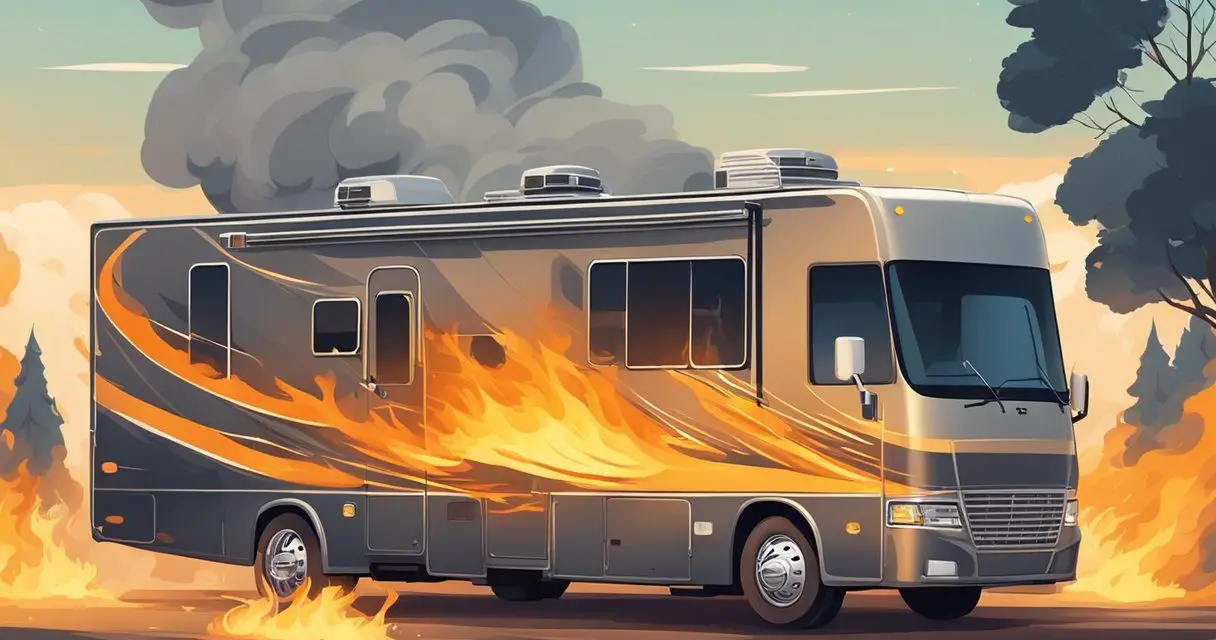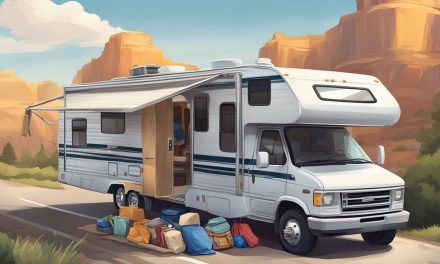Would you like to save this article?
The fires in California have been devastating. Our hearts and support go out to everyone involved, especially those who have been evacuated, lost their homes and especially those who lost loved ones.
Is there a way to avoid for these catastrophes? As many people in California experienced, even being prepared didn’t save their homes since the fires were so massive and the winds blew at such a tremendous speeds that it was virtually impossible to extinguish the fires.
Owning an RV can bring you a lot of freedom and adventure, but it also comes with certain risks, like the potential for fires. Luckily, unlike a home, you can move your RV to safer locations. Whether you’re parked at a campground or on the road, having an RV fire is something every RVer dreads to think about.
It’s crucial to know how to protect your RV and ensure your safety during such emergencies. By being proactive, you not only safeguard your investment but also keep yourself and your loved ones safe. Understanding the best ways to prepare can make all the difference.
1. Install a fire alarm
Installing a fire alarm in your RV is critical for your safety. This is the first line of defense to alert you in case of a fire, giving you precious time to react.
Choose a smoke alarm specifically designed for mobile settings, which can handle the bumps and vibrations of travel. This ensures reliable performance every time you hit the road.
Place fire alarms in key areas like the kitchen and sleeping quarters. These are common spots where fires may start, so having alarms there increases your chances of early detection.
Test the alarms regularly. A simple button press once a month can assure you that they’re working properly. Don’t forget to replace batteries biannually, even if they still seem to work.
Consider installing carbon monoxide alarms. They offer additional protection from this invisible, odorless gas, especially if your RV has gas appliances or a generator.
Easily accessible fire extinguishers should complement your fire alarms. Quick access in an emergency is just as important as the alarm itself. Check them periodically to ensure they’re ready to use when needed.
With these measures in place, your RV becomes a safer place, giving you more peace of mind on your adventures.
2. Keep a fire extinguisher
Ensuring you have a fire extinguisher in your RV is vital. Fires can break out unexpectedly, and having the right equipment can mean the difference between a minor incident and a major disaster.
You should keep at least one extinguisher within reach of the main entrance. This is a requirement by the National Fire Protection Association.
Consider having multiple extinguishers in your RV. Each extinguisher should be suitable for different fire classes, like A, B, C, and K. This ensures you’re prepared for various types of fires you might encounter.
Make sure the extinguisher is easy to use. Familiarize yourself with how it operates and check its pressure gauge regularly, ensuring it’s always ready for use.
An extinguisher is a must-have for safety during your travels. It’s a small investment that offers peace of mind on the road. Always remember, safety first!
3) Use flame-retardant covers
When it comes to keeping your RV safe during a fire, using flame-retardant covers is a smart move. These covers are designed to resist ignition and slow the spread of flames. They’re a reliable choice for adding an extra layer of protection to your vehicle.
Look for fire-retardant tarps that comply with recognized standards like NFPA 701 or CPAI-84. These certifications indicate that the cover has been tested for flammability and durability. Investing in a cover with these standards can help safeguard your RV against potential fire hazards.
Fire-retardant tarps serve as excellent protection for high-risk areas. They help shield parts of your RV that could be more susceptible to flames or intense heat. Whether you’re camping in a wildfire-prone area or parking in a sunny spot, these tarps offer peace of mind.
Remember, flame-retardant covers aren’t just for emergencies; they can also protect against everyday wear and tear. By choosing a durable, fire-resistant cover, you not only enhance fire safety but also extend the life of your RV’s exterior.
4) Avoid parking near dry grass
Parking your RV on or near dry grass might seem convenient, but it’s a risky move. Hot engines and exhaust systems can easily ignite dry vegetation. This is especially a concern in the warmer months, so aim for gravel or paved areas.
Before setting up camp, take a quick look around. Ensure you’re not parked on dry grass, brush, or leaves. Even a small patch can be a potential fire hazard. By parking on safer surfaces, you minimize the risk of starting a fire under your vehicle.
In many cases, choosing a safe parking location is just about being mindful of your surroundings. Look for designated parking areas that keep distance from natural fuels. Developed roadside pull-outs are often better suited for your RV, ensuring you’re not directly in contact with anything flammable.
5) Check for leaking propane
Checking for propane leaks is super important when it comes to keeping your RV safe from fire hazards. Start by using a simple soapy water solution. Mix a cup of water with a spoon of dish soap.
Brush or spray this solution onto any propane connections or joints in your RV. If you see bubbles forming, it means there’s a leak. It’s an easy trick that helps people catch issues early before they become dangerous.
Make sure you’re familiar with the smell of propane, often described as rotten eggs. If you notice this smell, make it a priority to extinguish any open flames or smoking materials. Turn off the propane supply immediately.
Sometimes, it might be worth getting a professional to inspect your setup. Regular inspections can add an extra layer of security and peace of mind. Many RV dealers offer thorough inspections of your propane system and make sure everything’s working as it should.
Knowing what to do if a leak is detected can save you a lot of trouble. You want to be ready to shut off the supply when necessary. If you notice a strong odor or bubbles, take action promptly to keep your RV safe.
6) Seal windows with heat-resistant film
When it comes to protecting your RV during a fire, sealing your windows with heat-resistant film can make a big difference. This special film adds an extra layer of defense by reducing the likelihood of heat or flames penetrating through the glass.
Heat-resistant film not only helps in fire situations but also offers UV protection and energy efficiency. It filters out harmful rays and keeps your RV cooler in the summer, which is a nice bonus while you’re on the road.
Applying the film is relatively straightforward. Clean the window surface to remove any dust or debris before you start. Once the window is clean, carefully apply the film, ensuring there are no air bubbles trapped between the film and the glass.
An important thing to consider is the thickness of the film. Thicker films usually offer more protection against heat and flames. Make sure to choose a film that best suits your needs and budget.
By taking this simple step, you can enhance the safety of your RV without a major investment. Plus, it’s something you can easily do yourself, adding a personal touch to your RV’s safety measures.
7) Create a fire exit plan
Creating a fire exit plan for your RV is essential for safety. Start by mapping out all possible exits in your RV, including doors, windows, and emergency hatches.
Discuss the plan with everyone in your RV. Make sure everyone, including kids, knows the escape routes. It’s essential to have this information clearly understood by all.
Inlcude your pets in the plan. Have a designated place outside as a meeting point for everyone to gather after exiting the RV swiftly.
Practicing the plan regularly is crucial. Run through the escape routes and meeting points to build confidence. This ensures everyone can get out quickly and safely in an emergency. Maintaining a routine check of these escape points keeps them operational and free of obstruction.
Prioritizing a fire exit plan safeguards everyone’s well-being on your travels. It’s one of the most practical steps for peace of mind.





